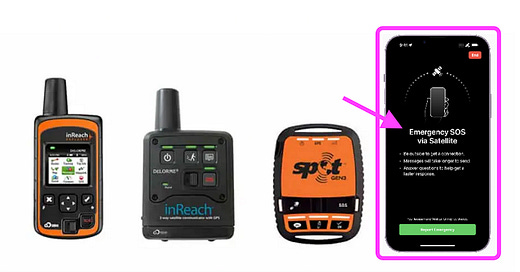Article by Eric Miller
Did you know—you may already have an emergency satellite messenger for your boat adventures, and not even know it? No, I’m not talking about the fancy InReach or SPOT devices that cost hundreds of dollars and run on proprietary satellite networks for a monthly fee. I’m talking about a device you already have—in fact, you might actually be reading this article on the very same device.
Yep, I’m talking about your cell phone.
For me, the cell phone is already a kind-of-a-big-deal piece of navigation and safety gear. It’s become indispensable for all kinds of boat trips, from bareboating a 46’ catamaran with the family in the Exumas, to minimalist solo dinghy adventures around the islands of western Lake Erie. It provides invaluable navigation tools like the workhorse Navionics, and safety tools like my anchor drag alarm app, that allows me to define a radius from my anchor drop point, and get an alarm if the boat should drift outside that radius. And, provided I’m within range of a cell tower on land, I can get up-to-the minute wind data using the Windy app, and weather however you please - even download GRIB files if I’m feeling particular about finely slicing and dicing weather data.
But, it's that ‘within range of a cell tower’ bit where the cell phone starts to lose its utility. Sure, maps can be downloaded for offline use, and GPS does not require a data signal to work - so we can still get some use out of the thing. But the ability to communicate and get updated weather data is a critical need, even without cell service - and especially in the event of an emergency. So, this is the hole that has typically been filled by the many dedicated Personal Locator Beacon/Satellite Messenger products, as well as sat phones, satellite hotspots like StarLink, and even the ‘Digital Selective Calling’ (DSC) emergency feature of my handheld VHF radio.
But, just about 2 years ago, that ‘within range of a cell tower’ limitation was removed on many new models of phones - both iPhone and Android. Now, many newer models of cell phones come with emergency satellite connectivity as a standard feature. Here’s a quick breakdown of how it works:
The feature works anywhere in the U.S., and iPhone users may have access in a few other countries.
Requires an unobstructed view of the sky
It is can only be used as a backup communication method when a normal cell signal is unavailable
Messaging is limited to text only—just like most of the PLB/Sat Messaging devices
The feature is only available on newer phones that are equipped with satellite radios. Currently, this is: Apple (iPhone 14 and later) Google (Pixel 9 series), and the Samsung Galaxy S25 series.
Both Apple and Google are leveraging the Skylo satellite network directly
Samsung is partnering with Verizon (who has in turn partnered with Skylo) to provide Emergency SOS to Galaxy S25 series owners
And, here’s how to use it:
iPhone Users
Ensure you have a supported phone running iOS 18 or later
You can text SOS emergency services whenever cell and wifi are unavailable (911 in the U.S. for example). Your GPS location, medical ID information, and emergency contacts will automatically be included in the SOS call.
You can share your location via satellite using Find My Device
You can use iMessage/SMS to send text messages to contact without a cell signal.
You can test satellite messaging on your own device by going to Settings > Emergency SOS and selecting "Try Demo."
Android Users
Ensure you have a supported phone and Android OS
The Pixel phones allow you to contact emergency services via when a cell signal is unavailable.
Like Apple, Google will include your GPS location and emergency contacts
To use satellite messaging on Pixel phones, enable Google Messages as your default messaging app
To make an emergency call with no cell service, you dial (not text) 911, then choose the Satellite SOS option that appears.
You can test it out by going to Settings > Safety & emergency > Satellite SOS and following the prompts.
Also, if you are a T-Mobile user…
T-Mobile is partnering with Starlink to enter the satellite enabled phone arena. This is particularly interesting, because the integration is planned to introduce emergency satellite features on existing hardware. According to the vendor, T-Mobile's Starlink service does not require you to buy a new phone; most modern smartphones are compatible with the service and can utilize Starlink connectivity without needing a special device, allowing you to use your existing phone to access satellite internet through T-Mobile.
They’ve also opened up the beta test to customers currently using Verizon and AT&T. T-Mobile is giving those customers the opportunity to try out T-Mobile Starlink satellite service on their existing phones. According to the website, during the beta period, Verizon and AT&T customers can experience T-Mobile Starlink text messaging for free, and once the service launches in July, it will be available for $20/month per line.
With safety being an ever-present first principle in the small boat community, it’s really great to see emergency satellite communications becoming available as a standard service, available on ubiquitous hardware. The additional piece of mind and ability to communicate in an emergency is well worth investing the time to learn about the capabilities of your current phone and provider. And, it's something to keep in mind for small craft skippers when upgrading phones or plans—to consider getting a new phone (or plan) that supports these new emergency satellite communication features. •SCA•




Wow. That article alone was worth the cost of my subscription. Thanks!
I've been looking for an excuse to update my iphone (besides getting a better camera), and this tips the scale. Thanks! I might even attend a few classes and actually learn how to use my phone properly....